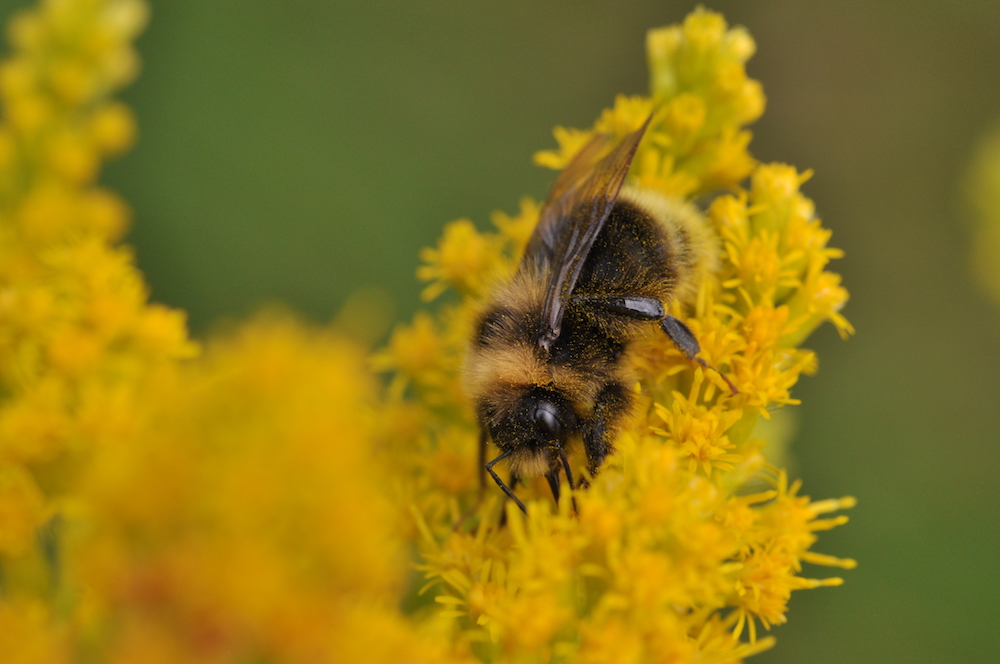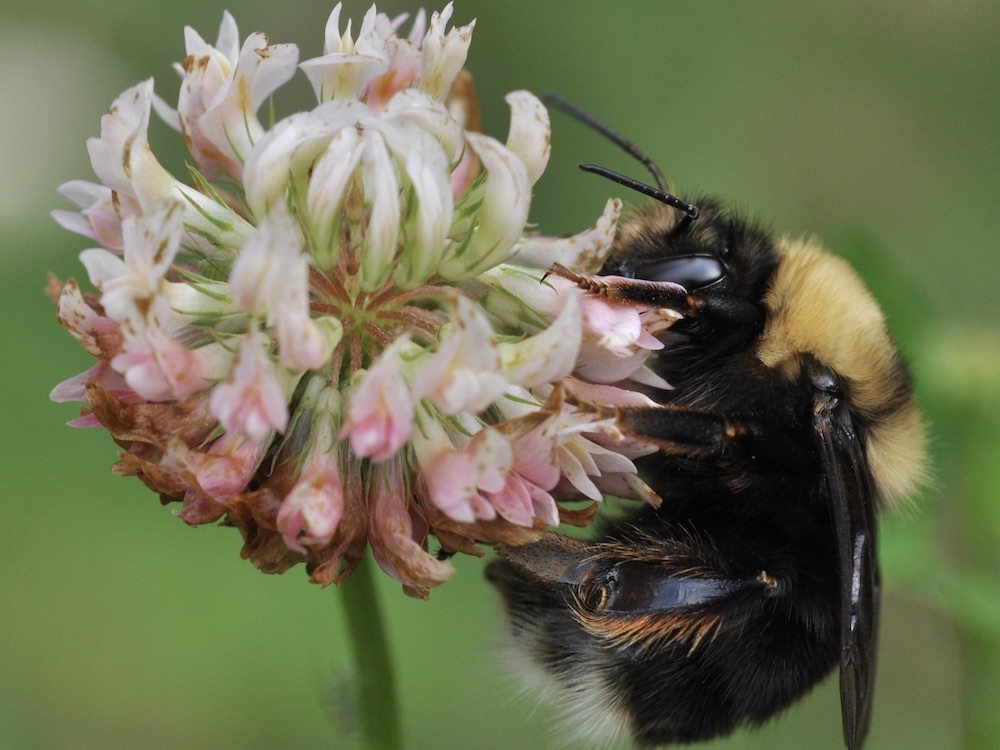B.C.’s once most common bee has been devastated by climate change, according to a report created for the U.S. government to determine whether the insect should be protected under the country's Endangered Species Act.
Heat waves and droughts have decreased the fuzzy, white-bummed bee’s presence by 57 per cent since 1998 across its wide-ranging habitat, which stretches from Alaska to central California and inland into the Northwest Territories, southern Saskatchewan and South Dakota.
As climate change progresses. The western bumble bee, or Bombus occidentalis, could be all but wiped out from its historic habitat, which ranges from alpine meadows to forests to Prairie grassland.
When generalist species that can exist in a wide range of habitats are being harmed by climate change, it's a signal that less noticeable species are also suffering, says Will Janousek, a biologist with the U.S. Geological Survey and co-lead author of the report.
Sarah Johnson, a PhD candidate at Simon Fraser University who specializes in bumble bees says the U.S. report's findings reflect what's happening in Canada — western bumble bees are in trouble.
But how at-risk these bees are for population collapse and whether it's climate change or a combination of a number of human-caused stressors that's decimating western bumble bee populations is hard to say, she says.
The Committee on the Status of Endangered Wildlife in Canada designated the western bumble bee species Bombus occidentalis occidentalis as “threatened” and Bombus occidentalis mckayi as “of special concern” in May 2014. B.C. also considers the bee to be “of special concern.” While the designation “endangered” comes with legal protections in Canada, “threatened” and “of special concern” do not.
The U.S. report, published recently in the Proceedings of the National Academy of Sciences journal, tracked the presence of the bee across its different U.S. habitats from 1998 to 2020, combining 23 years of data, 14,457 surveys and 2.8 million square kilometres.
It found a mean 57 per cent decline in the occurrence of species across western North America. In some places, like around Yellowstone National Park, there was only a 15 per cent decline. Pacific Northwest coastal forests along Washington and Oregon saw a 75 per cent decline.
Another way to look at this is if in 1998 you went to 10 random locations in western Washington state, you'd find western bumble bees in six places, Janousek says. In 2020 you'd find the bee in one out of 10 locations.

The biggest thing hurting the bees is heat, Janousek says. Heat had almost three times the effect of drought, which had the second-biggest impact.
Western bumble bees can be stressed or even killed when the thermostat creeps above 30 C, SFU’s Johnson says.
Janousek adds that heat impacts these bees year-round. In the winter warm temperatures can pull a queen bee out of hibernation, forcing her to burn through energy stores as she waits for spring to arrive. Warm springs can lure queen bees out of their burrows before plants are blooming and starve them, or expose them to spring cold snaps. And summer heat waves can kill bees outright, as well as reducing the number of days they’re able to forage.
Heat had twice as much of an impact than the researcher’s “other” category, which tracked the combined impact of things like disease, wildfire and livestock grazing practices, he adds.
Droughts make plants produce fewer flowers and lower-quality pollen and nectar, Janousek says. Droughts can also kill or prevent plants from growing, which can mean bees are without food for stretches of time.
And as climate change worsens, so will its impact on bees. The report modelled three future scenarios ranging from 2.2 C to 4.7 C of warming and found that even the most optimistic outcomes will see occupancy declines in half the places where these bees are found. Nearly 5 C of warming would cause declines in all habitats ranging from 51 to 97 per cent.
The report also tracked the impact of agricultural use of chemicals that kill bugs (insecticides), plants (herbicides) and fungus like mould or mildew (fungicides) on bees from 2008 to 2014. An insecticide group called nitroguanidine neonicotinoids or “neonics,” which are used in Canada, were shown to strongly impact the bees.
But it's not necessarily the insecticide that's the problem — it's how we use it, says Paul van Westendorp, B.C.’s provincial apiculturist. It's standard for seed producers to douse their product in neonics regardless of the actual need for it, he says. This is similar to the human over-use of antibiotics, he says. Antibiotics are great in small, targeted situations but broad application leads to superbugs in hospitals.
Buying neonics-free seeds costs more for farmers, van Westendorp adds.
Neonics are absorbed into the plant so it only impact insects that bite into it, he says. But because of the broad application the presence of neonics is higher in the environment and bees are exposed when, for example, dirt blows around, he says.
A “more responsible” strategy is to use integrated pest management, which combines several different techniques, van Westendorp says. For example, if a farmer finds a pest in their crops they should also check how many insects that will prey on that pest are present before turning to insecticides as a last option.
It would be possible to “significantly” reduce the use of neonics in the U.S. without reducing the amount of food produced, the U.S. report notes. Reducing the use of neonics could even increase the amount of food produced due to improved pollination, it continues.
Van Westendorp says “extreme population fluctuations are quite common” for bumble bees and it’s difficult to say how bees have been faring over the past 100 years, though it's clear humans and their land use policies have has a “huge impact on pollinators in general.”
When we cut down forests and plant fields with high amounts of flowering plants, that creates more food for bees, he says, but destroying undisturbed habitat takes away places that bees could live and forage.
From the late 1980s to 1990s western bumble bees were used exclusively in western North American greenhouses for crop pollination, until an intestinal disease in 1999 wiped the bees out and producers started using the common eastern bumble bee, Bombus impatiens, instead, van Westendorp says.
During that decade it’s unclear how many wild western bumble bees were harvested for greenhouse use, which could be another factor that drove down this bee's population, van Westendorp says. “They could have been hunted until the populations was not viable — we don’t know.”
Johnson says she’s working on a hypothesis about how the decade of commercial production led the bee to be more susceptible to getting sick, which makes them more vulnerable to climate change and other stressors.
Climate change is impacting bumble bees in different ways. While some species like the western bumble bee appear to be suffering, others are booming.
That’s a problem as different habitats are taken over by the same bug because in the future a single event could impact all of these insects at the same time, Johnson says.
“The more ‘the same’ these environments become the less diversity we have stored in our back pocket,” she says. “Species that are adapting now may not be able to adapt to a different aspect of climate change in the future.”
Van Westendorp also says the decline in biodiversity is one of his “biggest concerns.”
Crops that are pollinated by a diverse set of pollinators, like bees, butterflies, moths and flies, grow “much better” than using a single type of bee, he says.
A blueberry farmer whose crop flowers early in the season would be able to grow more food by the end of the season if they let a fraction of their field grow wildflowers and native plants, than if they planted the whole field with blueberries, van Westendorp says.
“To diversify your dependency on [commercial] pollinators create an environment to support wild pollinators, like leaf cutter bees and bumble bees,” he says. “We’re telling them to plant smorgasbords for those insects along the edges of fields.”
Van Westendorp says he’ll often hear from folks who say they want to support the bees so they’ve decided to start bee keeping.
That’s not necessary, he’ll tell them.
“The best thing the average Joe can do to support pollinator populations is to plant more forage plants that are nectar and pollen producing and to change gardening habits,” he says.
Think like a bee — there’s no food value in the “green deserts” of grassy lawns, he adds.
Johnson agrees. “We need a radical societal values change” to protect habitat and the creatures that call that habitat home, she says.
She also recommends people check out the Native Bee Society of BC, an organization she is the founding president of, for resources on how to support bee diversity, advocate for protecting parkland, tearing out ornamental gardens and replacing them with native plants and using the iNaturalist app and Bumble Bee Watch website to participate in citizen science that tracks bee sightings.
“If we don’t get a handle on runaway capitalism and climate change it’ll run us all off the cliff along with the bees,” she adds. ![]()
Read more: Science + Tech, Environment
















Tyee Commenting Guidelines
Comments that violate guidelines risk being deleted, and violations may result in a temporary or permanent user ban. Maintain the spirit of good conversation to stay in the discussion.
*Please note The Tyee is not a forum for spreading misinformation about COVID-19, denying its existence or minimizing its risk to public health.
Do:
Do not: